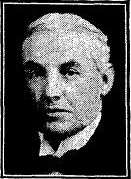Donald Maclean (British politician)
| The Right Honourable Sir Donald Maclean KBE | |
|---|---|
 | |
| Leader of the Opposition | |
|
In office 14 December 1918 – 12 February 1920 | |
| Monarch | George V |
| Prime Minister | David Lloyd George |
| Preceded by | H. H. Asquith |
| Succeeded by | H. H. Asquith |
| President of the Board of Education | |
|
In office 25 August 1931 – 15 June 1932 | |
| Prime Minister | Ramsay MacDonald |
| Preceded by | Hastings Lees-Smith |
| Succeeded by | Edward Wood |
| President of the Liberal Party | |
|
In office 1923 – 14 October 1926 | |
| Leader | H. H. Asquith |
| Preceded by | J. M. Robertson |
| Succeeded by | J. A. Spender |
| Member of Parliament for North Cornwall | |
|
In office 30 May 1929 – 15 June 1932 | |
| Preceded by | Alfred Williams |
| Succeeded by | Francis Acland |
| Member of Parliament for Peebles and Southern Midlothian Peebles and Selkirk (1910–1918) | |
|
In office 19 December 1910 – 15 November 1922 | |
| Preceded by | William Younger |
| Succeeded by | Joseph Westwood |
| Member of Parliament for Bath | |
|
In office 8 February 1906 – 10 February 1910 | |
| Preceded by | Edmond Wodehouse |
| Succeeded by | Lord Alexander Thynne |
| Personal details | |
| Born |
Donald Maclean 9 January 1864 Farnworth, Bolton, Lancashire |
| Died |
15 June 1932 (aged 68) London |
| Nationality | British |
| Political party | Liberal |
| Spouse(s) | Gwendolen Margaret Devitt (m. 1907; his death 1932) |
Sir Donald Maclean, KBE (9 January 1864 – 15 June 1932) was a Liberal Party politician in the United Kingdom. He was Leader of the Opposition between 1918 and 1920 and served in Ramsay MacDonald's National Government as President of the Board of Education between 1931 and his death in June of the following year.
Biography
Born in Farnworth, Bolton, Lancashire, Maclean was the eldest son of John Maclean, a cordwainer originally of Kilmoluaig, Tiree in the Inner Hebrides, and his wife Agnes Macmellin.[1]
Maclean practised as a solicitor with practices in Cardiff and Lincoln's Inn Fields, London. A member of the Presbyterian Church of England, he was vice-president of the Cardiff Free Church Council in 1902-3, and also worked closely with the National Society for the Prevention of Cruelty to Children. He was a last-minute choice as one of the Liberal Party candidates in Bath at the 1900 general election, but was defeated at the polls.[2] At the 1906 general election, he stood again and was elected as a Liberal Member of Parliament for the constituency.[3] Whilst an MP he voted in favour of the 1908 Women's Enfranchisement Bill.[4]
He lost his seat at the January 1910 general election, but moved constituency at the December 1910 general election and was returned for Peebles and Selkirk,[5] a seat he held until 1918,[6] and then represented Peebles and South Midlothian between 1918 and 1922[6] and the Northern Division of Cornwall between 1929 and 1932.[7]
Maclean was appointed a Privy Counsellor in 1916,[8] and was knighted in 1917.[9] He was Leader of the Liberal Parliamentary Party from 1918 to 1920, as the leader of the Liberal Party, H. H. Asquith had lost his seat in the House of Commons. For those two years he also served as Leader of the Opposition, while Labour had no official leader and Sinn Féin refused to participate in parliamentary government.[10]

Towards the end of his life, Maclean joined the National Government headed by Ramsay MacDonald. He served as President of the Board of Education from 1931 to 1932.
He died from cardiovascular disease on 15 June 1932 at the age of sixty-eight.
Family
Maclean married Gwendolen Margaret Devitt (26 September 1880 – 23 July 1962) daughter of Andrew Devitt (1850–1931) and wife Jane Dales Morrison (1856–1947), on 2 October 1907. They and their eldest son, Ian, are buried in the churchyard of Holy Trinity Church, Penn, Buckinghamshire. Another of his sons was the diplomat and spy, Donald Duart Maclean.
References
- History of the Liberal Party 1895–1970, by Roy Douglas (Sidgwick & Jackson 1971)
- Who's Who of British Members of Parliament, Volume III 1919–1945, edited by M. Stenton and S. Lees (Harvester Press 1979)
- ↑ ‘MACLEAN, Rt Hon. Sir Donald’, Who Was Who, A & C Black, an imprint of Bloomsbury Publishing plc, 1920–2007; online edn, Oxford University Press, Dec 2007 accessed 17 March 2014
- ↑ "The Popular Guide to the House of Commons" (Pall Mall Gazette "Extra"), February 1906, p. 48.
- ↑ leighrayment.com House of Commons: Baillieston to Beckenham
- ↑ http://hansard.millbanksystems.com/commons/1908/feb/28/womens-enfranchisement-bill-1
- ↑ "The Popular Guide to the House of Commons" (Pall Mall Gazette "Extra"), January 1911, p. 136.
- 1 2 leighrayment.com House of Commons: Paddington to Platting
- ↑ leighrayment.com House of Commons: Cornwall to Cynon Valley
- ↑ The London Gazette: no. 29454. p. 1117. 28 January 1916.
- ↑ London Gazette Issue 30250 published on 24 August 1917. Page 5
- ↑ Douglas in The History of the Liberal Party 1895–1970 observes that "The technical question whether the Leader of the Opposition was Maclean or William Adamson, Chairman of the Parliamentary Labour Party, was never fully resolved ... The fact that Adamson did not press his claim for Opposition leadership is of more than technical interest, for it shows that the Labour Party was still not taking itself seriously as a likely alternative government"
External links
- Hansard 1803–2005: contributions in Parliament by Donald Maclean
- Biography at liberalhistory.org.uk